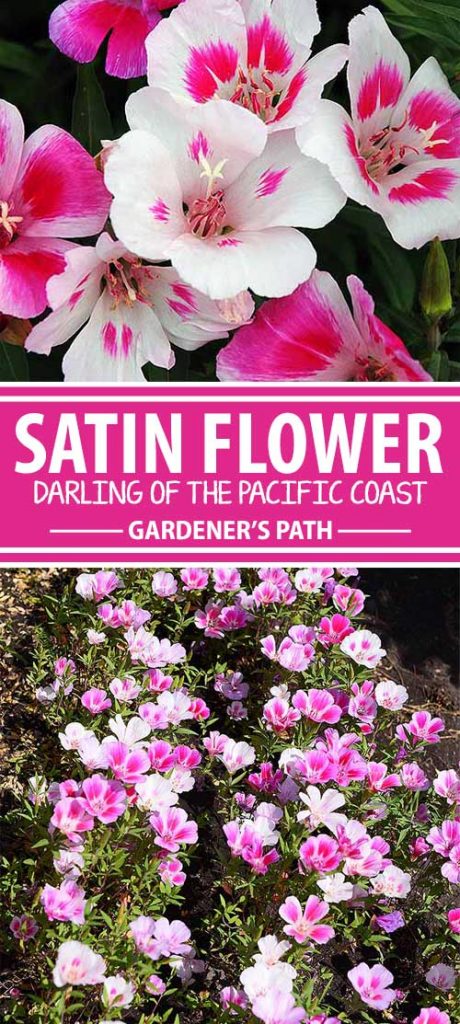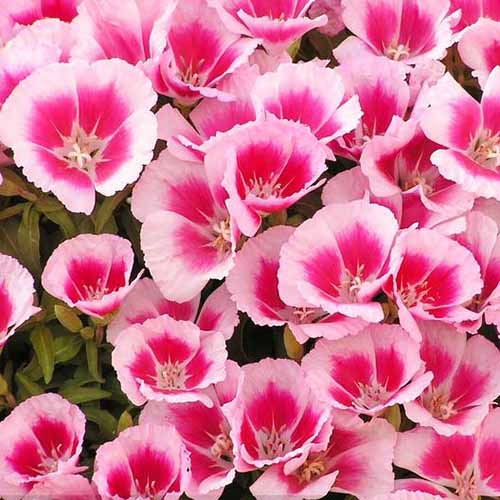Clarkia amoena
Satin flower, Clarkia amoena, aka godetia, is an annual native wildflower in the Onagraceae family that also includes evening primrose and fuchsia.
Colors include peach, pink, purple, red, and white, often with striking variegation.
From beds to borders, containers to cutting gardens, the fresh-faced blossoms of silky satin flower are sure to bid visitors to your home a cheery welcome.
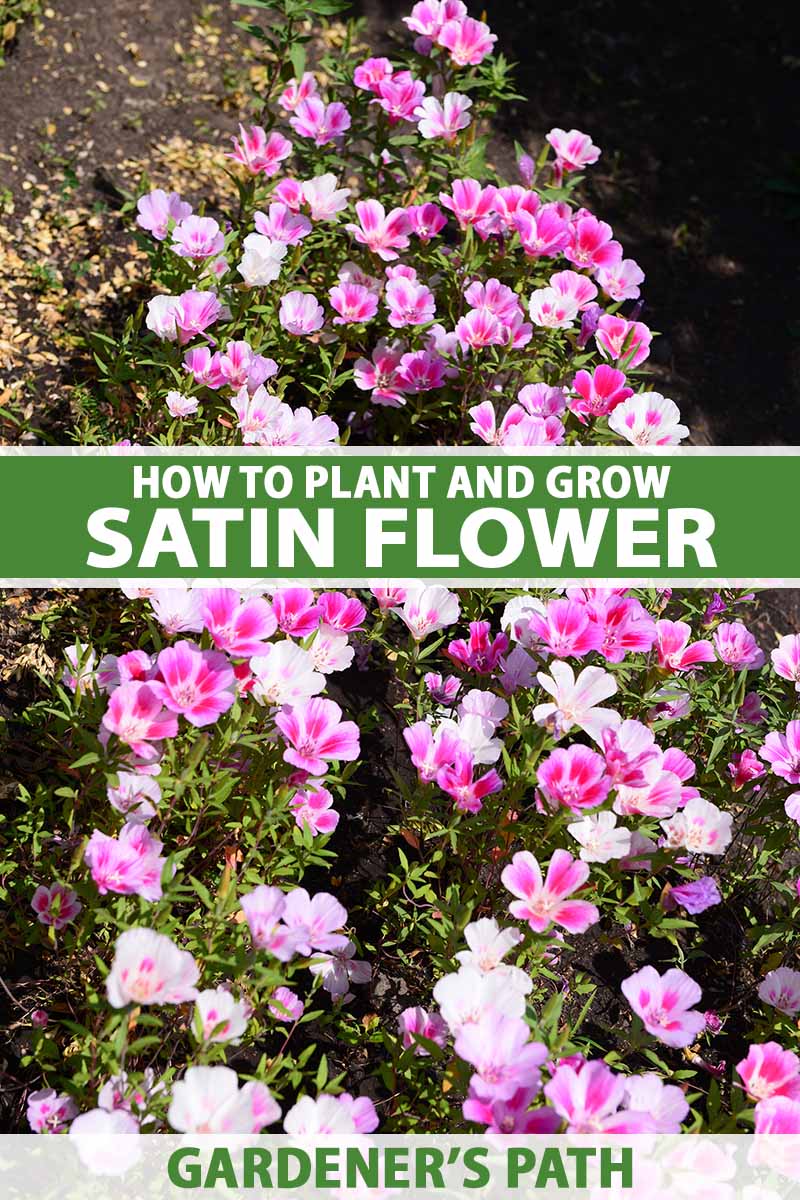
We link to vendors to help you find relevant products. If you buy from one of our links, we may earn a commission.
Read on to learn how to grow this early-season bloomer in USDA Hardiness Zones 2 to 11.
Here’s what I’ll cover:
What You’ll Learn
Let’s get started!
Cultivation and History
Also called farewell to spring, satin flower appears on the rugged hills of the Pacific Coast in early summer. From British Columbia to California, its poppy-like blossoms cast a pinkish hue over the western terrain.
And while they look nothing alike, take care not to confuse it with another satin flower, Sisyrinchium striatum, aka pale yellow-eyed grass, or you may order the wrong seeds!
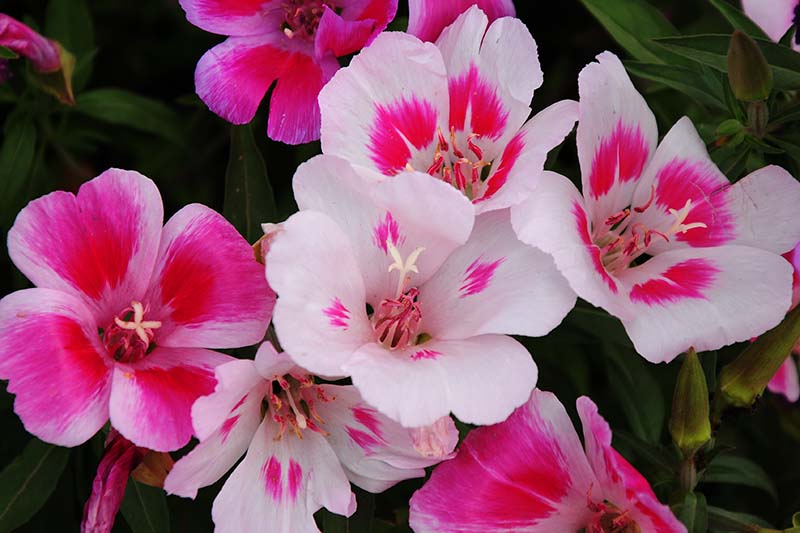
There are over 40 species in the Clarkia genus. Most are native to western North America, where seeds were commonly ground for consumption by indigenous Californians including the Sierra Miwok.
One species, C. tenella, is native to South America.
Some of the Clarkia species were originally classified as Godetia, named after Swiss botanist Godet.
They were later reclassified into the broader Clarkia genus, purportedly named for early 1800s American West explorer William Clark, of the famous Lewis and Clark expedition.
It is for this reason that you may find satin flower listed as Godetia amoena when you are shopping for seeds and plants.
In addition to C. amoena, there are a handful of subspecies in the wild, and numerous cultivated varieties have been developed for the home garden.
Satin flower is a hardy summer annual that thrives with full sun exposure in average, well-drained soil.
It does best in cooler regions where temperatures don’t usually exceed the 80s, and benefits from some afternoon shade in the warmest zones.
In the wild, colors generally range from pink to purple.
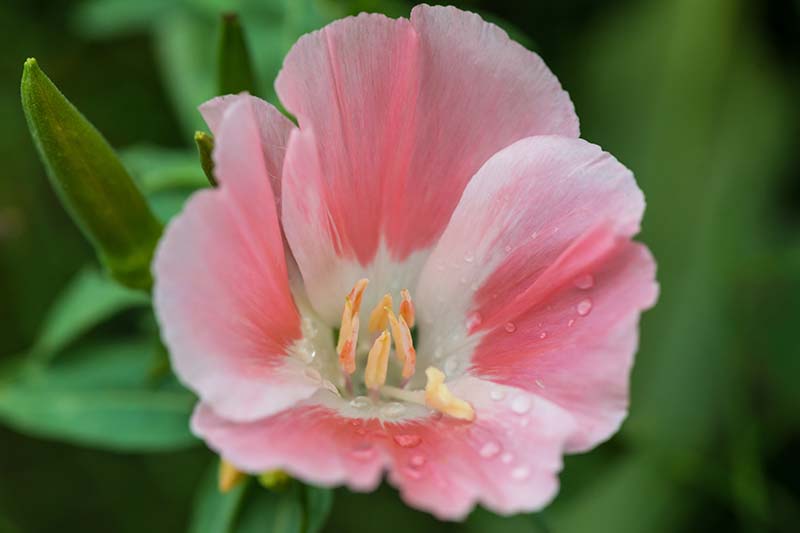
Today’s cultivars broaden the palette with exciting peach, red, and white options, as well as fuller petals, and larger, more numerous blooms.
Plants have upright stems that range from 12 to 36 inches tall, depending upon the variety. They achieve a spread of nine to 12 inches, and have a clumping growth habit.
Lance-shaped foliage has smooth margins. It is fuzzy with fine hairs and may shade slightly toward gray or red.
Like those of asters, the lower leaves often fall off by the time plants bloom, leaving them with bare “legs.”
The flowers are cup-shaped and approximately one and a half inches long. They may appear singly or in clusters at the terminal ends of the stems in late spring to summer.
Propagation
To grow your own plants, start them from seed.
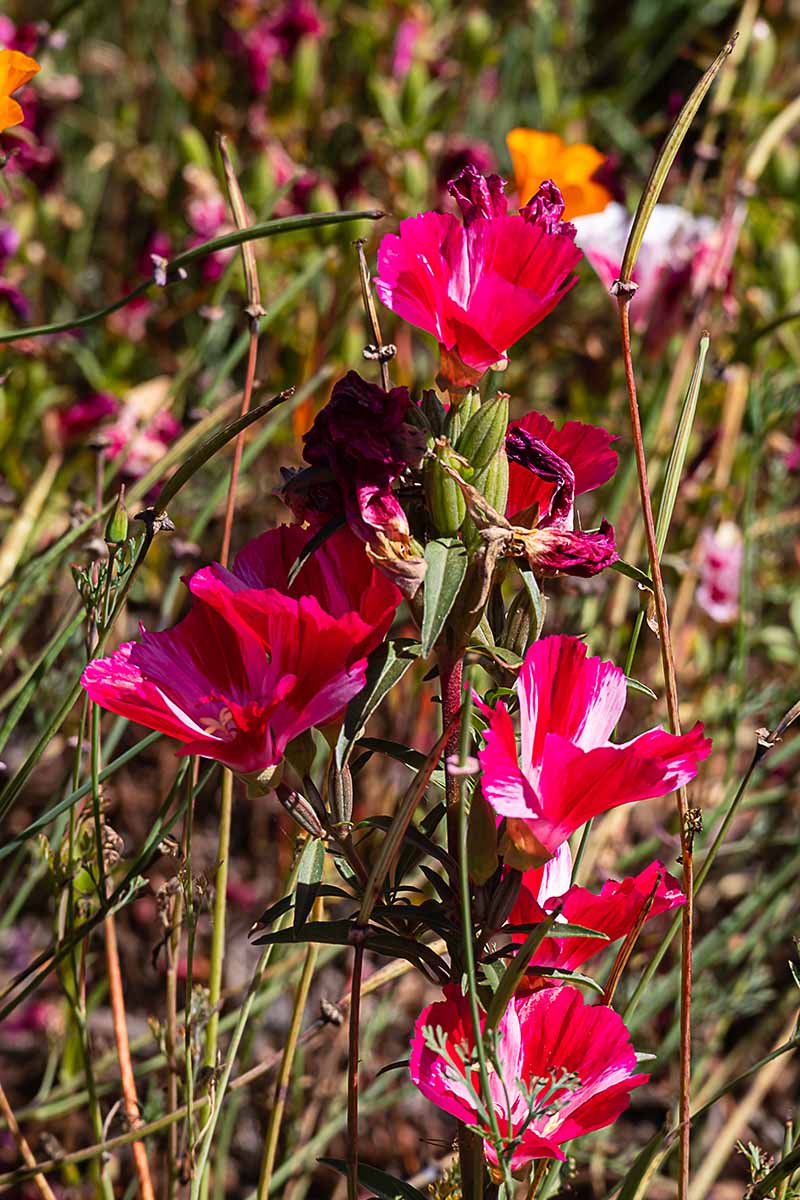
You can start seeds indoors four to six weeks prior to the last frost date for a jump on the growing season. Remember, this is a cool-weather plant that won’t do well once summer heats up.
A drawback of starting seeds in containers indoors is that seedlings require transplanting, which may disturb the roots. To minimize transplant stress, use biodegradable seed starter cells and plant them in their entirety.
Alternatively, you can sow seeds outdoors in early spring as soon as the last average frost date has passed.
If you live along the West Coast, sow seeds or transplant nursery pots in the spring, or pre-seed in the fall.
C. amoena self-sows and returns each year in the West, so you may find you only have to plant once. However, note that the seeds from hybrid plants may produce variable results.
How to Grow
To cultivate this plant at your house, find a location with full sun. If you’re in one of the warmest regions, a little afternoon shade is beneficial.
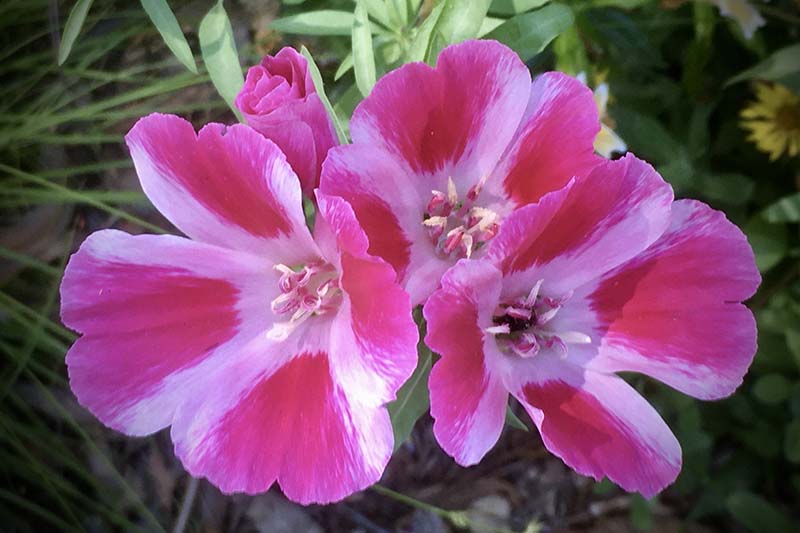
The soil can be of average quality, provided it drains well. The ideal pH is between 6.0 and 8.0. To determine yours, conduct a soil test through your local agricultural extension.
Work the soil to a depth of six to 12 inches, until it is crumbly. Fertilization is not necessary, as it can cause excessive and scraggly foliar growth at the expense of blooms.
Moisten the soil and scatter seeds over it. Do not bury them, as they need light to germinate. Keep the soil moist, but not soggy, during germination.
When the seedlings have two sets of true leaves, thin them to a distance of nine to 12 inches apart, depending upon the mature width of the type you are growing. Find this information on your seed packet.
Good air circulation between plants is essential, to keep the humidity down and avoid activating mold spores.
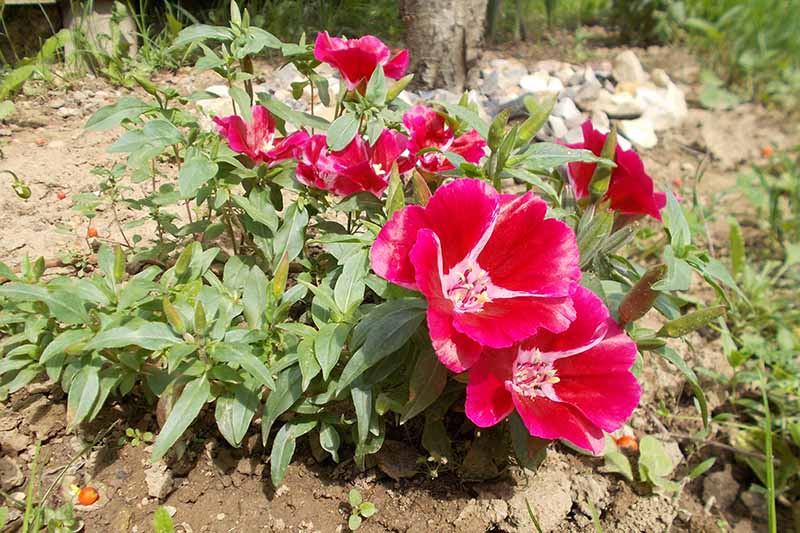
For mass plantings, such as large drifts or meadows, broadcast one pound of seed per acre, for 19 to 25 seeds per square foot.
Here is a broadcast spreader you may like:
With the Scotts Whirl Hand-Powered Spreader, you can comfortably broadcast tiny wildflower seeds in a 180-degree swath.

Scotts Whirl Hand-Powered Spreader
It’s the perfect choice for areas that measure 5,000 square feet or less.
You can find the Scotts Whirl Hand-Powered Spreader available from Scotts via Amazon.
Once established, plants don’t need a lot of water. If it doesn’t rain during the week, give them a drink. Be sure to aim your hose nozzle at the soil, not the leaves, to avoid increasing the ambient humidity and stimulating fungal growth.
For container gardening, find a pot with drainage holes that can accommodate the mature dimensions of the variety you are planting. It should have a depth of 12 to 24 inches.
Growing Tips
This annual is easy to grow when you remember a few key points:
- The soil doesn’t have to be rich, but it needs to drain well.
- Surface sow the tiny seeds; do not bury them.
- Broadcast seeds for mass plantings like meadows.
- Plant in part shade in the warmest regions.
- Space to accommodate mature dimensions and promote air circulation.
- Water the roots, not the leaves.
Maintenance
Satin flower requires minimal maintenance.
Remember to maintain even moisture during germination and water as needed thereafter.
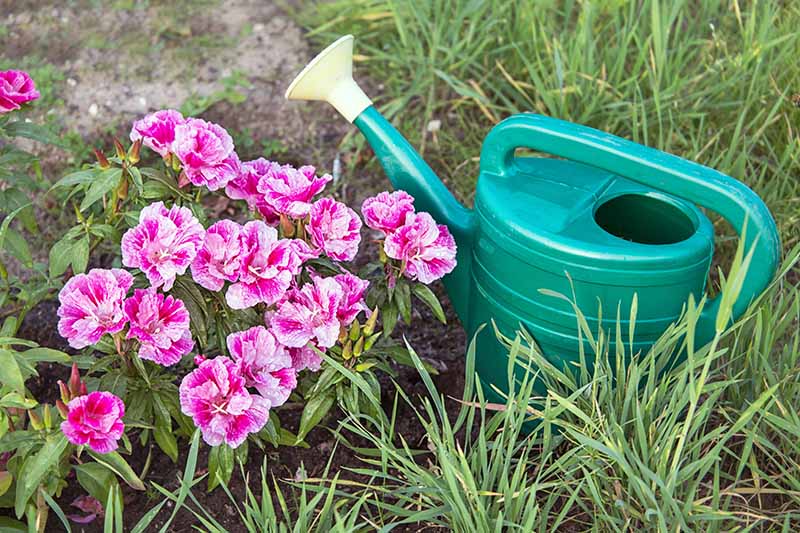
Deadhead spent blooms to encourage plants to produce more.
Weed regularly to avoid competition for water, deter insects, promote air circulation, and inhibit pathogens.
With heights ranging from 12 to 36 inches, you may be wondering about staking.
Plants in full sun that have not been fertilized are the least likely to require support. However, those that are in heavy shade, and/or have become leggy due to overfeeding, are the most likely to require assistance to remain upright.
And finally, as this is an early season bloomer, when it’s finished, remove the spent stems to the ground to make way for the next round of plants to take center stage.
Cultivars to Select
When shopping for seeds or plants, you are likely to find them listed as Godetia, with a cultivar name that follows.
Here are two you may like:
Farewell to Spring
‘Farewell to Spring’ has vivid bicolor blooms.
Sweet as cotton candy, light pink blossoms blush deeper pink in the center, creating depth and contrast that catch the eye and draw it into the showy display.
With heights of 12 to 24 inches, this charmer can fill mid-placement needs as a lively backdrop to lower-profile specimens in front positions.
Find ‘Farewell to Spring’ seeds now from Eden Brothers in one-ounce and quarter-pound packages.
Sybil
‘Sybil’, aka ‘Sybil Sherwood,’ has pastel blossoms, for a soft, serene presentation.
Dreamy salmon-pink blossoms with cream centers are as refreshing as sherbet on a warm summer day.

At 18 inches tall, plants are spectacular in naturalistic, knee-high meandering drifts.
Find ‘Sybil’ seeds now from Outsidepride via Amazon in packages containing 5,000 or 10,000.
Also, C. amoena is often included in California wildflower seed mixes that contain a variety of compatible plants. However, they sometimes contain non-native species, so read closely if you want to choose all endemic plants.
Managing Pests and Disease
As I always say, the best defense against pests and disease is a healthy plant.
With quality seeds, by avoiding both under- and over-watering, practicing regular weeding, and allowing for appropriate spacing, you’re going to be ahead of the game when it comes to warding off problems.
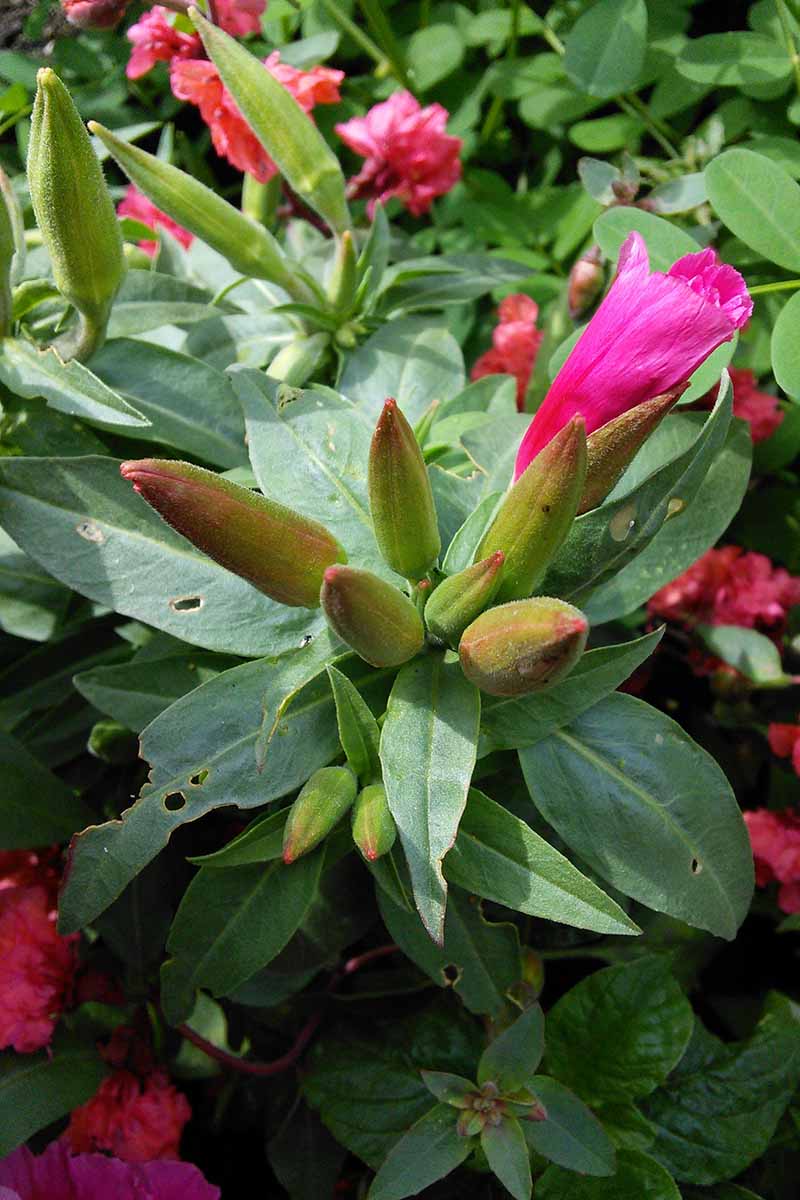
However, even with best practices, factors beyond our control – like excessive rainfall – can start trouble.
Pests to be on the lookout for with satin flower are:
- Aphids
- Japanese Beetles
- Mites
These are all sap-sucking insects that can cause foliar deformity, desiccation, and death. If you can, pick them off and drop them into a bucket of soapsuds to destroy them.
An application of organic neem oil may also be helpful.
As for disease, the following may pose problems if conditions are too moist:
- Leaf Spot
- Powdery Mildew
- Stem Rot
- Verticillium Wilt
Leaf spot and powdery mildew adversely affect foliage, and are treatable with fungicide.
Stem rot and Verticillium wilt attack roots in the soil, and may cause irreversible damage and death.
Best Uses
Satin flower is suited to multiple garden placements.
Taller types make excellent anchors in foundation beds, with a middle and lower row of flora in front of them to take center stage after they’ve finished their early season bloom.

They also make a wonderful addition to tall wildflower meadows, where they can wave freely in the breeze.
Shorter stature varieties offer a more compact form that is suited to beds, borders, containers, and massing in drifts.
And guess what?
Deer don’t like this plant, but pollinators love it.
Sow C. amoena liberally in your butterfly, cottage, and cutting gardens with companions like California poppy, delphinium, larkspur, marigold, wallflower, and other annuals that share the same cultural requirements.
And if its beauty, native status, and appeal to beneficial insects aren’t enough, satin flower can also withstand alkaline, clay, salty, and sandy soil, as well as drought, so use it in those rugged areas you thought were unplantable.
Quick Reference Growing Guide
| Plant Type: | Flowering annual | Flower / Foliage Color: | Peach, pink, purple, red, variegated, white/green |
| Native to: | Western North America, South America | Tolerance: | Alkaline soil, clay soil, deer, drought, salt, sand |
| Hardiness (USDA Zone): | 2-11 | Soil Type: | Average |
| Bloom Time: | Late spring to summer | Soil pH: | 6.0-8.0 |
| Exposure: | Full sun to part shade | Soil Drainage: | Well-draining |
| Spacing: | 9-12 inches | Attracts: | Bees, beneficial insects, butterflies, moths |
| Planting Depth: | Surface sow | Companion Planting: | California poppy, delphinium, larkspur, marigold, wallflower |
| Height: | 12-36 inches | Uses: | Beds, borders, butterfly gardens, containers, cottage gardens, cutting gardens, foundation plantings, mass plantings, mixed wildflower meadows |
| Spread: | 9-12 inches | Order: | Myrtales |
| Water Needs: | Moderate | Family: | Onagraceae |
| Maintenance | Low | Genus: | Clarkia |
| Common Pests and Diseases: | Aphids, Japanese beetles, mites; leaf spot, powdery mildew, stem rot, verticillium wilt | Species: | Amoena |
A Sight to Behold
If you’re like me, you love to see color in the landscape after a long, barren winter.
The first satin flowers are a welcome sight on a soft, sunny day that hints of warm weather to come.

Annuals like this one are fun to grow. Buying seed is generally affordable, maintenance is usually low, and plants die to the ground at season’s end, so you can change up your gardens every year, if you like.
And while this plant is native to the Pacific Coast, growing it anywhere provides nectar and habitat for bees, butterflies, and beneficial insects.
Make this the year you try C. amoena.
Why not broadcast seed for masses of cheerful blossoms that blanket ground only recently released from winter’s icy grasp, and renew your soul with the sight of this darling wildflower?
Are you growing satin flower in your garden? Let us know in the comments section below!
If you found this guide informative and would like to read about more flowering annuals, check out these guides next:
